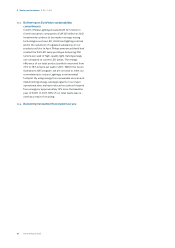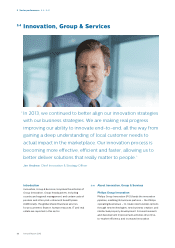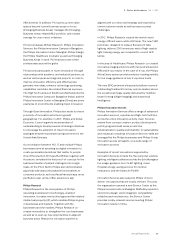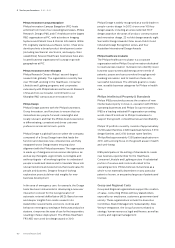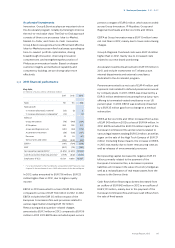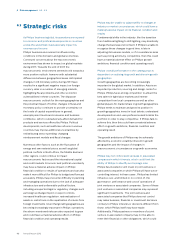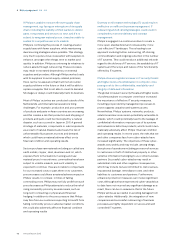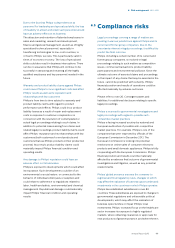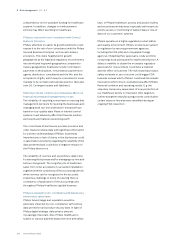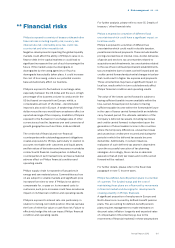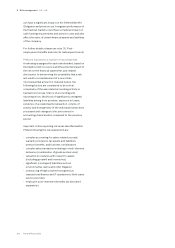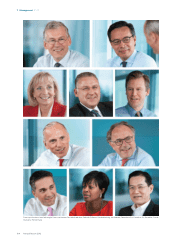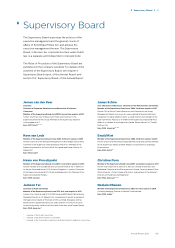Philips 2013 Annual Report Download - page 96
Download and view the complete annual report
Please find page 96 of the 2013 Philips annual report below. You can navigate through the pages in the report by either clicking on the pages listed below, or by using the keyword search tool below to find specific information within the annual report.6 Risk management 6.3 - 6.3
96 Annual Report 2013
6.3 Strategic risks
As Philips’ business is global, its operations are exposed
to economic and political developments in countries
across the world that could adversely impact its
revenues and income.
Philips’ business environment is influenced by
conditions in the domestic and global economies.
Continued concerns about the macroeconomic
environment has shown its impact on global markets
during 2013. Towards the end of 2013 the
macroeconomic environment seemed to tilt towards a
more positive outlook, however with substantial
dierences between geographical areas. Anticipated
changes in US monetary policy during 2013 have
resulted in a significant negative impact on foreign
currency rates in a number of emerging markets,
highlighting fiscal problems and other economic
vulnerabilities in these countries. The disparate
macroeconomic outlook for the main geographies and
the potential impact of further changes in fiscal and
monetary policy continues to provide uncertainty on
the levels of capital expenditures in general,
unemployment levels and consumer and business
confidence, which could adversely aect demand for
products and services oered by Philips. Political
developments, such as healthcare reforms in various
countries may impose additional uncertainties by
redistributing sector spending, changing
reimbursement models and fiscal changes.
Numerous other factors, such as the fluctuation of
energy and raw material prices, as well as global
political conflicts in North Africa, the Middle East and
other regions, could continue to impact
macroeconomic factors and the international capital
and credit markets. Economic and political uncertainty
may have a material adverse impact on Philips’
financial condition or results of operations and can also
make it more difficult for Philips to budget and forecast
accurately. Philips may encounter difficulty in planning
and managing operations due to the lack of adequate
infrastructure and unfavorable political factors,
including unexpected legal or regulatory changes such
as foreign exchange import or export controls,
increased healthcare regulation, nationalization of
assets or restrictions on the repatriation of returns from
foreign investments. Given that growth geographies are
becoming increasingly important in Philips’ operations,
the above-mentioned risks are also expected to grow
and could have a material adverse eect on Philips’
financial condition and operating results.
Philips may be unable to adapt swiftly to changes in
industry or market circumstances, which could have a
material adverse impact on its financial condition and
results.
Fundamental shifts in the industry, like the transition
from traditional lighting to LED lighting, may drastically
change the business environment. If Philips is unable to
recognize these changes in good time, is late in
adjusting its business models, or if circumstances arise
such as pricing actions by competitors, then this could
have a material adverse eect on Philips’ growth
ambitions, financial condition and operating result.
Philips’ overall performance in the coming years is
dependent on realizing its growth ambitions in growth
geographies.
Growth geographies are becoming increasingly
important in the global market. In addition, Asia is an
important production, sourcing and design center for
Philips. Philips faces strong competition to attract the
best talent in tight labor markets and intense
competition from local companies as well as other
global players for market share in growth geographies.
Philips needs to maintain and grow its position in
growth geographies, invest in local talents, understand
developments in end-user preferences and localize the
portfolio in order to stay competitive. If Philips fails to
achieve this, then this could have a material adverse
eect on growth ambitions, financial condition and
operating result.
The growth ambitions of Philips may be adversely
aected by economic volatility inherent in growth
geographies and the impact of changes in
macroeconomic circumstances on growth economies.
Philips may not control joint ventures or associated
companies in which it invests, which could limit the
ability of Philips to identify and manage risks.
Philips has invested or will invest in joint ventures or
associated companies in which Philips will have a non-
controlling interest. In these cases , Philips has limited
influence over, and limited or no control of, the
governance, performance and cost of operations of
joint ventures or associated companies. Some of these
joint ventures or associated companies may represent
significant investments. The joint ventures and
associated companies that Philips does not control
may make business, financial or investment decisions
contrary to Philips’ interests or decisions dierent from
those, which Philips itself may have made.
Additionally, Philips partners or members of a joint
venture or associated company may not be able to
meet their financial or other obligations, which could


